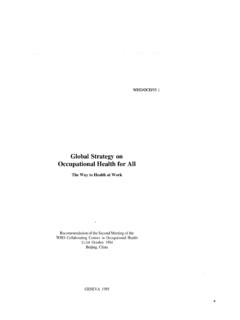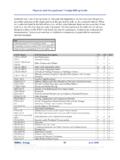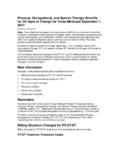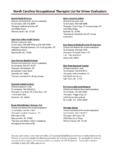Transcription of Occupational and Environmental Health Issues of …
1 THE WORLD BANK GROUP WASHINGTON, URBAN PAPERS UP-2. JULY 2006. Occupational and Environmental Health Issues of Solid Waste Management Special Emphasis on Middle- and Lower-Income Countries Sandra Cointreau URBAN. SECTOR. BOARD. Occupational and Environmental Health Issues of Solid Waste Management Special Emphasis on Middle- and Lower-Income Countries Sandra Cointreau URBAN. THE WORLD BANK. SECTOR. Washington, BOARD. 2006 The International Bank for Reconstruction and Development/The World Bank 1818 H Street NW. Washington, DC 20433. Telephone 202-473-1000. Internet The findings, interpretations, and conclusions expressed here are those of the author and do not necessarily reflect the views of the Board of Executive Directors of the World Bank or the governments they represent. To order additional copies of this publication, please send an e-mail to the Urban Help Desk, Urban publications are available on-line at Occupational AND Environmental Health Issues OF SOLID WASTE MANAGEMENT iii TABLE OF CONTENTS.
2 ACKNOWLEDGEMENTS .. v PREFACE .. vii INTRODUCTION .. 1. Occupational Health Risks .. 1. Environmental Health Risks .. 2. CONTEXT SOLID WASTE 2. Current Situation in Middle and Lower-income 3. Solid Waste 3. Solid Waste Composition .. 4. Waste Collection 6. Waste Disposal Systems .. 7. Solid Waste Management 7. Health AND INJURY 9. AVAILABILITY AND QUALITY OF Health AND INJURY Confounding 11. Anecdotal Information .. 11. SOLID WASTE HANDLING AND GENERAL Health RISKS ..12. BIRTH DEFECTS AND INFANT MORTALITY ..13. Municipal Solid Waste Landfills .. 13. Hazardous Waste Landfills .. 14. AIR POLLUTION DISEASE LINKS ..14. Allergic Pulmonary Diseases .. 16. Non-Allergic Pulmonary 19. Elevated Heavy Metals .. 20. Headaches and Landfill .. 22. Cancer .. 22. DIRECT CONTACT DISEASE LINKS ..24. Parasitic Infections .. 25. HIV and Hepatitis 25. WATER CONTAMINATION DISEASE LINKS ..26. VECTOR DISEASE LINKS ..27. Dengue Fever .. 27. Leptospirosis and Hanta Virus.
3 28. Cholera .. 28. Enteric Bacteria .. 28. ANIMAL FEEDING DISEASE LINKS ..28. Trichuriasis .. 29. Trichinella Spiralis .. 29. Taeniasis .. 30. Mad Cow Disease (bovine spongiform encephalopathy, BSE) .. 30. Highly Pathogenic Avian Influenza (H5N1) .. 30. Collection Injuries .. 30. Disposal Injuries .. 32. Dumpsite Slides .. 33. Lifting-Induced Musculoskeletal Injuries .. 34. Vibration-Induced Musculoskeletal Injuries .. 34. Occupational AND Environmental Health Issues OF SOLID WASTE MANAGEMENT iv Noise-Induced 35. RECOMMENDATIONS ..35. Near-Term .. 35. Special Precautions for Disposal Workers:.. 37. Long Term Overview: .. 38. NEXT LIST OF BOXES. Box 1. Disease and Injury Risks for Solid Waste Workers versus Control Baseline Populations .. 2. Box 2. Health Risk Factors for Solid Waste Workers .. 3. Box 3. Poorer Countries have Greater Worker Risks .. 3. Box 4. Occupational Health and Injury Box 5. Environmental Health and Injury Issues .
4 10. Box 6. Accra, Ghana, Occupational Health Data ..13. Box 7. Hazardous Gases in Trace Quantities at Municipal Solid Waste Facilities ..13. Box 8. Data on Elevated Bio-aerosol Exposure Levels for Solid Waste Workers ..16. Box 9. Data on Elevated Particulate Exposure Levels for Solid Waste Box 10. Data on Elevated Heavy Metals in Blood from Solid Waste Work ..20. Box 11. Elevated Levels of Parasitic Infection among Waste Pickers at Open Dumps ..25. Box 12. Diseases from Vectors in Contact with Solid Waste ..27. Box 13. Diseases from Eating Undercooked Meat of Animals in Contact with Solid Box 14. What is in a Health and Safety LIST OF TABLES. Table 1. Global Perspective on Solid Waste Quantities .. 4. Table 2. Global Perspective on Urban Solid Waste 5. Table 3. Global Perspective on Costs for Proper Solid Waste Management Costs Versus 8. Table 4. Disposal Costs by Alternative Technologies for Large Cities .. 9. Table 5. Concentrations of Airborne Occupational AND Environmental Health Issues OF SOLID WASTE MANAGEMENT v ACKNOWLEDGEMENTS.
5 The author is grateful for inspiration and Health data provided by the Catholic Missionary working to relieve some of the daily suffering of waste pickers at Payatas Dump in Manila. Christine Furedy, Professor of Sociology at York University, and James Listorti, public Health expert at the World Bank, provided useful direction and references. Numerous unpublished studies and raw data were graciously provided by various sociologists, Health workers, and solid waste managers working in and with developing countries. Dr. Joel Levine, Physician and Senior Professor of Internal Medicine at the University of Connecticut's School of Medicine, reviewed the work in progress for accurate use of medical terminology and concepts and internal consistency. Dr. Philip Rushbrook, Regional Advisor Waste Management Advisor at the World Health Organization, European Centre for Environment and Health , Rome encouraged the author to expand on her earlier work and provided many useful references from European sources, as well as peer review.
6 The advice and suggestions sought from the external reviews of the draft text are also gratefully acknowledged: Dr. Roberto Bertollini, WHO, EURO, Copenhagen, Denmark Dr. Boguslaw Baranski, WHO, EURO, Copenhagen, Denmark Dr. Michel Krzyzanowski, WHO, Bonn, Germany Mr. Ian MacArthur, CIEH, London, UK. Mr. Robert Foster, Borough Council of King's Lynn and West Norfolk, UK. Dr. Ashok Shekdar, NEERI, Nagpur, India Dr. Thomas Novotny, World Bank, Washington DC, USA. Dr. Gunter Klein, WHO, EURO, Copenhagen, Denmark Dr. MZ Ali Khan, WHO, CEHA, Amman Jordan Mr. Raki Zghondi, WHO, CEHA, Amman, Jordan Dr. Alvaro Cantanhede, WHO, CEPIS, Lima, Peru Dr. Hisashi Ogawa, WHO, WPRO, Manila, The Philippines Dr. Deoraj Caussy, WHO, SEARO, New Delhi, India Ms Annette Pruess, WHO, HQ, Geneva, Switzerland Mr. Kristof Bostoen, Nairobi, Kenya Occupational AND Environmental Health Issues OF SOLID WASTE MANAGEMENT vii PREFACE. An overview is presented of the available Health literature for causes of diseases, injuries, and accidents from solid waste management technologies.
7 Illnesses discussed include infectious diseases, allergies, respiratory damage, and cancers. Some diseases are derived from direct ingestion of infectious micro-organisms, others involve infection through contamination of the food chain, whereby animals or other vectors have ingested infectious micro-organisms. Injuries include joint and spinal damage, fractures, puncture wounds, damage to eyes and ears. Accidents include slides from unstable disposal piles, cave-ins of disposal site surfaces, fires, explosions, being caught in processing equipment, and being run over by mobile equipment. The solid waste management technologies discussed include collection, recycling, processing, and disposal technologies. The information contained in this document will be useful to a wide audience, including: City officials who need to develop programs and systems to protect city workers and residents from Health risks related to public cleansing activities.
8 Environmental groups who monitor government services and interact in permitting procedures through public participation;. Health practitioners observing work or proximity-related Health impacts;. Solid waste management planners and designers; and Lawyers and labor representatives involved in negotiating solid waste contracts or labor agreements. Significant effort was made to obtain literature from developing countries, supplemented by personal contacts and fieldwork in over 40 countries1. Much of that literature is unpublished and considered anecdotal, as it was acquired directly from Health practitioners in the field and was not part of a rigorous statistically validated study with peer review. Nevertheless, it has been used judiciously to describe the seriousness of Health problems confronted by solid waste workers and waste pickers, particularly in many middle- and lower-income countries. All of the Health Issues reported from high-income countries are directly applicable to developing countries, but risk levels can be multiplied in the latter because protective measures are seldom implemented in poorer countries.
9 The handling of wastes involves more manual contact too. Where available, older data is also provided for the high-income countries. Historical Health data from high- income countries is often more applicable to developing countries than recent data, because risk reduction, protective measures and pollution control systems now expected in higher-income- countries were largely implemented only in the past 20 years. Provoked by the many injuries and diseases the author observed at solid waste facilities in developing countries, the background research by the author for this publication has been accumulated over several years. The Waste Management Unit of the World Health Organization (WHO), Regional Office for Europe, encouraged the work to expand her effort to enable this publication to be prepared. The WHO arranged for the peer review and final editing/formatting. The practical follow-up to this publication would be through initiatives to encourage improved record keeping on Health impacts, increased research on specific Health risks, and greater worker protection.
10 1. Sandra Cointreau's work on solid waste in developing countries has included direct field experience in: South America and Caribbean: Ecuador and the Galapagos Islands, El Salvador, Jamaica, Haiti, Peru, Colombia, Paraguay, Uruguay, Argentina, Mexico, Brazil, Dominican Republic, Guyana, Trinidad . Eastern Europe: Romania, Croatia, Montenegro, Hungary, Latvia, Turkey;. Asia: India, Bangladesh, Pakistan, Sri Lanka, Uzbekistan, Kazakhstan, Thailand, Philippines, South Korea, Vietnam, Cambodia, Indonesia, People's Republic of China;. North Africa/Middle East: Morocco, Tunisia, West Bank/Gaza, Jordan, Syria, Iraq;. Africa: Mauritius, Nigeria, Guinea, Ghana, Gambia, Senegal, Tanzania, Mozambique, and Sierra Leone. Occupational AND Environmental Health Issues OF SOLID WASTE MANAGEMENT: WITH SPECIAL EMPHASIS ON MIDDLE AND LOWER-INCOME COUNTRIES. INTRODUCTION. All activities in solid waste management involve risk, either to the worker directly involved, or to the nearby resident.


















